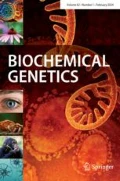Abstract
Restriction endonuclease fragment length variants in mice were compared by Southern blot analysis using the cDNA probe pcXP33 for the chymotrypsin gene. The variants were detected in the restriction patterns generated by fragments from digestions withBglII,EcoRI,HindIII,Pstl,SacI, andXbaI. The set of protein phenotypes and the restriction patterns of chymotrypsin gene were examined in many laboratory strains and wild subspecies. Most laboratory strains (26 strains) are grouped into a set defined as Set 1, but only a few laboratory strains (AU/SsJ and five BALB/c sublines) are classified as belonging to Set 2. Of wild subspecies, only BRV-MPL (M. brevirostris) can be placed in Set 1, while DOM-BLG and SK/Cam (M. domesticus) belong in Set 2. The assignment of an appropriate set defined by the characteristics of the chymotrypsin gene has also been investigated inM. musculus, two Chinese subspecies,M. yamashinai, M. molossinus, andM. castaneus, and the evolutionary relationship between laboratory mice and various subspecies ofMus has been examined.
Similar content being viewed by others
References
Bell, G. I., Quinto, C., Quiroga, M., Valenzuela, P., Craik, C. S., and Rutter, W. J. (1984). Isolation and sequence of a rat chymotrypsin B gene.J. Biol. Chem. 25914265.
Bonhomme, F., Catalan, J., Britton-Davidian, J., Chapman, V. M., Moriwaki, K., Nevo, E., and Thaler, L. (1984). Biochemical diversity and evolution in the genusMus. Bichem. Genet. 22275.
Ferris, S. D., Sage, R. D., and Wilson, A. C. (1982). Evidence from mtDNA sequences that common laboratory strains of inbred mice are descended from a single female.Nature 295163.
Ferris, S. D., Sage, R. D., Prager, E. M., Ritte, U., and Wilson, A. C. (1983). Mitochondrial DNA evolution in mice.Genetics 105681.
Miyashita, N., Moriwaki, K., Minezawa, M., Yonekawa, H., Bonhomme, F., Migita, S., Yu, Z., Lu, D., Cho, W. S., and Thohari, M. (1985). Allelic constitution of the hemoglobin beta chain in wild populations of the house mouse,Mus musculus.Biochem. Genet. 23975.
Morton, J. J. (1966). The multiple electrophoretic bands of mouse hemoglobins.Genet. Res. 776.
Nei, M., and Li, W.-H. (1979). Mathematical model for studying genetic variation in terms of restriction endonucleases.Proc. Natl. Acad. Sci. USA 765269.
Rigby, P. W., Dieckmann, M., Rhodes, C., and Berg, P. (1977). Labeling deoxyribonucleic acid to high specific activityin vitro by nick translation with DNA polymerase I.J. Mol. Biol. 113237.
Ritte, U., and Neufeld, E. (1982). East Asian hemoglobin type (Hbb p) in wild populations of the house mouse in Israel.Biochem. Genet. 20475.
Sage, R. D., Whitney, J. B., III, and Wilson, A. C. (1986). Genetic analysis of a hybrid zone between domesticus and musculus mice (Mus musculus complex): Hemoglobin polymorphism.Curr. Top. Microbiol. Immunol. 12575.
Schwarz, E., and Schwarz, H. K. (1943). The wild and commensal stocks of the house mouse,Mus musculus Linnaeus.J. Mammal. 2459.
Selander, R. K., and Yang, S. K. (1969). Protein polymorphism and genic heterozygosity in a wild population of the house mouse (Mus musculus).Genetics 63653.
Southern, E. M. (1975). Detection of specific sequences among DNA fragments separated by gel electrophoresis.J. Mol. Biol. 98503.
Suzuki, H., Miyashita, N., Moriwaki, K., Kominami, R., Muramatsu, M., Kanchisa, T., Bonhomme, F., Petras, M. L., Yu, Z., and Lu, D. (1986). Evolutionary implication of heterogeneity of the nontranscribed spacer region of ribosomal DNA repeating units in various subspecies ofMus musculus.Mol. Biol. Evol. 3 126.
Taylor, B. A., and Rowe, L. (1984). Genes for serum amyloid A proteins map to chromosome 7 in the mouse.Mol. Gen. Genet. 195491.
Wahl, G. M., Stern, M., and Stark, G. R. (1979). Efficient transfer of large DNA fragments from agarose gels to diazobenzyloxymethyl-paper and rapid hybridization by using dextran sulfate.Proc. Natl. Acad. Sci. USA 763683.
Watanabe, T., and Tomita, T. (1974). Genetic study of pancreatic proteinase and α-amylase in mice (Mus musculus).Biochem. Genet. 12419.
Watanabe, T., Ogasawara, N., and Goto, H. (1976a). Genetic study of pancreatic proteinase in mice (Mus musculus): Genetic variants of trypsin and chymotrypsin.Biochem. Genet. 14697.
Watanabe, T., Ogasawara, N., and Goto, H. (1976b). Genetic study of pancreatic proteinase in mice (Mus musculus): Linkage of thePrt-2 locus on chromosome 8.Biochem. Genet. 14999.
Watanabe, T., Miyashita, N., Moriwaki, K., and Hilgers, J. (1987). Evolutionary relationships between laboratory mice and subspecies ofMus musculus based on the genetic study of pancreatic proteinase loci,Prt-1, Prt-2, Prt-3 andPrt-6.Biochem. Genet. 25239.
Yonekawa, H., Moriwaki, K., Gotoh, O., Watanabe, J., Hayashi, J. I., Miyashita, N., Petras, M. L., and Tagashira, Y. (1980). Relationship between laboratory mice and the subspeciesMus musculus domesticus based on restriction endonuclease cleavage patterns of mitochondrial DNA.Jpn. J. Genet. 55289.
Yonekawa, H., Moriwaki, K., Gotoh, O., Miyashita, N., Migita, S., Bonhomme, F., Hjorth, J. P., Petras, M. L., and Tagashira, Y. (1982). Origins of laboratory mice deduced from restriction patterns of mitochondrial DNA.Differentiation 22222.
Author information
Authors and Affiliations
Rights and permissions
About this article
Cite this article
Watanabe, T., Miyashita, N., Nishimura, M. et al. Evolutionary relationships between laboratory mice and subspecies ofMus musculus based on the restriction fragment length variants of the chymotrypsin gene at thePrt-2 locus. Biochem Genet 27, 119–130 (1989). https://doi.org/10.1007/BF00563022
Received:
Revised:
Issue Date:
DOI: https://doi.org/10.1007/BF00563022




